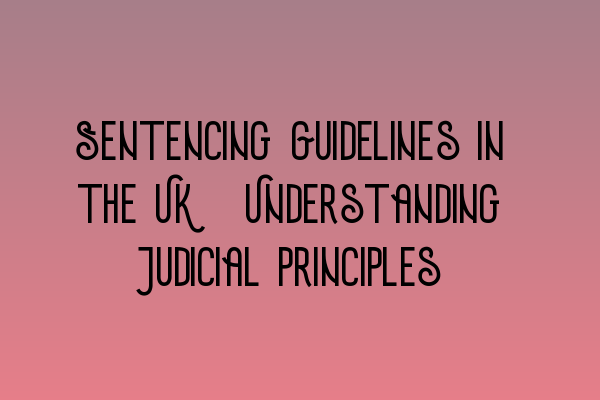Sentencing Guidelines in the UK: Understanding Judicial Principles
Sentencing guidelines play a crucial role in the criminal justice system of the United Kingdom. They provide a framework for judges and magistrates to determine the appropriate punishment for offenders based on the severity of the crime and other relevant factors. Understanding these guidelines is essential for anyone involved in criminal law practice, whether as a solicitor, barrister, or legal professional.
The Purpose of Sentencing Guidelines
The primary objective of sentencing guidelines is to ensure consistency and fairness in the sentencing process. They aim to promote transparency and allow for the public to have confidence in the criminal justice system. By providing clear guidance, these guidelines help to achieve proportionality in sentencing, where similar offenses are treated similarly.
It is important to note that sentencing guidelines are not binding, but they hold significant weight in the decision-making process. Judges are expected to follow the guidelines unless there are exceptional circumstances that justify deviating from them. These guidelines help ensure that sentencing decisions are made in line with established principles and with reference to relevant case law.
Factors Considered in Sentencing
When determining an appropriate sentence, judges take into account various factors, including the seriousness of the offense, the offender’s culpability, any aggravating or mitigating factors, and the impact on the victim. The specific guidelines produced by the Sentencing Council provide detailed instructions on how these factors should be assessed and weighed.
Seriousness of the Offense
The gravity of the offense is a crucial factor in determining the sentence. The guidelines specify different levels of seriousness for different offenses, with corresponding sentencing ranges. These ranges provide guidance on the minimum and maximum custodial sentences, fines, or community orders that may be imposed.
For example, for offenses involving violence, the guidelines may consider the severity of the injury caused, whether a weapon was used, and any premeditation or planning involved. These factors help the judge assess the appropriate level of punishment.
Culpability of the Offender
The offender’s culpability is assessed based on their level of involvement in the crime. This includes considerations such as whether the offender played a leading or subordinate role, whether the crime was premeditated or opportunistic, and any relevant previous convictions or cautions. The guidelines provide criteria to help judges assign culpability levels, which in turn influence the sentence.
Aggravating and Mitigating Factors
Aggravating and mitigating factors can significantly impact the final sentence. Aggravating factors include things like prior convictions, targeting vulnerable victims, or committing the offense while on bail. Mitigating factors, on the other hand, may include remorse, cooperation with authorities, or evidence of rehabilitation. The presence of these factors can lead to adjustments to the sentence within the permissible range specified in the guidelines.
Impact on the Victim
The impact of the offense on the victim is a crucial consideration in the sentencing process. Judges are encouraged to take into account the harm caused, both physical and emotional, and consider any long-term effects on the victim’s life. This factor can influence the severity of the sentence, particularly in cases involving crimes against vulnerable individuals.
Conclusion
Understanding sentencing guidelines is essential for legal professionals practicing criminal law in the UK. By familiarizing themselves with these guidelines, solicitors and barristers can effectively advocate for their clients and help ensure fair and appropriate sentencing.
If you’re interested in further preparing for your SQE exams or exploring other related topics, we recommend checking out our SQE 1 Practice Exam Questions and SQE 1 Practice Mocks FLK1 FLK2 articles. Additionally, if you’re looking to advance your legal career, our SQE 2 Preparation Courses and SQE 1 Preparation Courses may be of interest to you. Stay updated with the latest SRA SQE exam dates by visiting our SRA SQE Exam Dates page.
